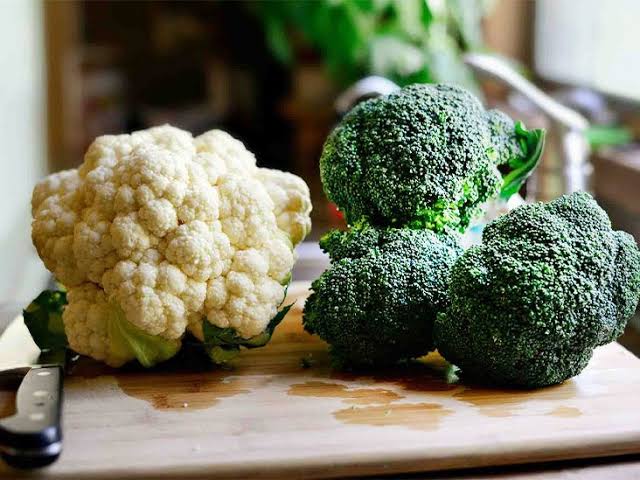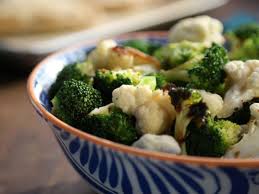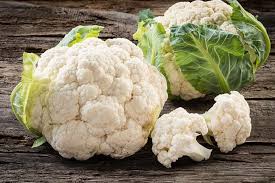Broccoli and cauliflower are two popular vegetables, often mistaken for each other due to their similar appearance. However, these cruciferous veggies have distinct characteristics that set them apart.
Broccoli, with its vibrant green color and tree-like structure, has a firm texture and a slightly bitter taste. On the other hand, cauliflower showcases a pale white or light-colored head, resembling a dense, compact bouquet. One notable difference is that while broccoli has a leafy stem, cauliflower tends to have a thicker, more solid stem.
Moving beyond their appearances, these vegetables also differ in taste and nutritional profiles, broccoli carries a slightly bitter and earthy flavor, whereas cauliflower is known for its mild and slightly nutty taste. Both, however, are low in calories and high in essential nutrients, making them excellent choices for a healthy diet.
In terms of nutritional content, both broccoli and cauliflower are rich in vitamins C and K, providing a boost to the immune system and aiding in blood clotting. Additionally, they are good sources of fiber, promoting digestive health. Despite their differences, both vegetables share the same family – Brassicaceae, which is known for its health-promoting properties.
These cruciferous vegetables also boast antioxidant compounds, such as sulforaphane, known for its potential anti-cancer properties. Regular consumption of broccoli and cauliflower has been associated with various health benefits, including reducing inflammation and supporting cardiovascular health.
When it comes to culinary uses, these versatile vegetables offer a wide range of possibilities. Broccoli can be enjoyed steamed, roasted, or stir-fried, while cauliflower can be mashed, riced, or roasted to create delicious and nutritious dishes. Their adaptability makes them valuable additions to various cuisines worldwide.
However, while broccoli and cauliflower may share a family and appear similar at first glance, they differ in taste, appearance, and texture. Embracing these differences allows individuals to appreciate the unique qualities each vegetable brings to the table, both in terms of culinary versatility and nutritional benefits.
Beyond their individual characteristics, broccoli and cauliflower contribute significantly to a balanced and health-conscious lifestyle. These cruciferous vegetables are not only delicious additions to meals but also offer a myriad of health advantages.
One key aspect of both broccoli and cauliflower is their role in supporting bone health. Both vegetables are rich in vitamin K, an essential nutrient for bone metabolism and the prevention of osteoporosis. This, coupled with their considerable calcium content, makes them valuable allies in maintaining strong and healthy bones.
Moreover, these vegetables contribute to the overall well-being of the cardiovascular system. The presence of fiber, potassium, and antioxidants in broccoli and cauliflower plays a pivotal role in regulating blood pressure, reducing cholesterol levels, and enhancing heart health. Including these veggies in a balanced diet can thus be seen as a proactive step towards cardiovascular wellness.
The cruciferous family, to which both broccoli and cauliflower belong, is renowned for its cancer-fighting properties. Sulforaphane, a compound present in these vegetables, has shown promise in combating certain types of cancer by promoting detoxification and inhibiting the growth of cancer cells. Regular consumption may serve as a preventive measure against these serious health concerns.
In terms of dietary management, both broccoli and cauliflower are excellent choices for those aiming to control their weight. With their low-calorie content and high fiber levels, these vegetables provide a sense of fullness and satiety, aiding in weight management and promoting a healthy metabolism.
In the culinary realm, the versatility of broccoli and cauliflower shines through. From vibrant salads to hearty soups, these vegetables seamlessly integrate into a variety of dishes. Their ability to absorb flavors and enhance the overall taste of a meal makes them indispensable in kitchens worldwide. Whether roasted to perfection, sautéed with aromatic spices, or blended into a creamy soup, the possibilities are as vast as one’s culinary imagination.
While the differences between broccoli and cauliflower are evident, their collective impact on health and culinary experiences is profound. These cruciferous vegetables stand as pillars of nutrition, offering a delightful journey through flavors and a steadfast commitment to well-being. Embracing the diversity of broccoli and cauliflower is not just a culinary choice but a step towards a healthier and more vibrant lifestyle.
Read Also: Sloes: History, Nutrition, Health Benefits and Growing Guide
What are the Differences Between Broccoli and Cauliflower?

Broccoli and cauliflower, while sharing similarities, exhibit distinct differences in appearance, taste, and texture.
1. Appearance: Broccoli has a vibrant green color and a tree-like structure. Its head is composed of tightly packed florets, and it often has a leafy stem. Cauliflower, on the other hand, has a pale white or light-colored head, resembling a dense bouquet. The florets are tightly packed, creating a solid and compact appearance. Cauliflower typically has a thicker, more solid stem compared to broccoli.
2. Taste: Broccoli carries a slightly bitter and earthy flavor, the taste is robust and can vary depending on how it’s cooked. Cauliflower is known for its mild and slightly nutty taste, it tends to absorb the flavors of other ingredients in a dish, making it versatile for various culinary preparations.
3. Texture: Broccoli has a firm texture, and its florets are denser compared to cauliflower, the stem and florets maintain a certain crispness when cooked properly. Cauliflower is characterized by a crumbly and softer texture when cooked, it can be easily mashed or riced due to its less dense structure.
4. Color: Broccoli is primarily green, with variations in shade depending on maturity. Cauliflower can be white, but there are also colored varieties such as orange, purple, and green, adding diversity to its appearance.
5. Nutritional Content: Both broccoli and cauliflower belong to the cruciferous vegetable family and share similar nutritional profiles. They are low in calories and high in vitamins C and K, promoting immune health and blood clotting.
Understanding these differences allows for a more nuanced appreciation of each vegetable’s unique qualities, whether in the kitchen or in considering their nutritional contributions to a balanced diet. Beyond their appearances and flavors, the two cruciferous vegetables, broccoli, and cauliflower, also differ in terms of culinary uses and potential health benefits.
Cooking methods can highlight their distinct textures and tastes. Broccoli, with its robust florets and tender stems, is often steamed, roasted, or stir-fried to preserve its crunchiness. The versatility of broccoli allows it to absorb flavors, making it a popular choice in various dishes. Cauliflower, with its more delicate texture, is frequently mashed, riced, or roasted. The neutral taste of cauliflower makes it adaptable to various seasonings and cooking techniques.
Furthermore, these vegetables contribute differently to overall health. Broccoli, with its higher vitamin C content, supports immune function and acts as a potent antioxidant. Its fiber content aids digestion and helps maintain a healthy weight. Cauliflower, rich in vitamin K, plays a crucial role in bone health and blood clotting. Both vegetables, being part of the Brassicaceae family, share anti-cancer properties attributed to compounds like sulforaphane.
In terms of visual appeal, broccoli’s vibrant green hue adds color to dishes, while cauliflower’s white, cream, or purple tones create a visually pleasing contrast. This visual distinction can influence culinary presentations and choices in recipes.
While broccoli and cauliflower share commonalities as cruciferous vegetables, their differences extend beyond appearance and taste. Understanding these distinctions allows for a more nuanced appreciation of their unique qualities in both the kitchen and the realm of nutrition. Whether selecting one for its robust flavor or the other for its adaptability, both broccoli and cauliflower contribute to a diverse and nutritious culinary experience.
Read Also: Rambutans: History, Nutrition, Health Benefits and Growing Guide
The Similarities Between Broccoli and Cauliflower

Broccoli and cauliflower, despite their distinct appearances and flavors, share several similarities:
1. Cruciferous Family: Both broccoli and cauliflower belong to the cruciferous family, known for its health-promoting properties. This family includes other vegetables like kale, Brussels sprouts, and cabbage.
2. Nutrient Content: Both vegetables are rich in essential nutrients, including vitamins C and K. These vitamins contribute to immune system support (vitamin C) and bone health and blood clotting (vitamin K).
3. Low in Calories: Broccoli and cauliflower are low-calorie vegetables, making them suitable choices for those watching their calorie intake. This characteristic makes them valuable additions to a balanced and weight-conscious diet.
4. Fiber Content: Both vegetables are good sources of dietary fiber, promoting digestive health and providing a sense of fullness. Adequate fiber intake is essential for maintaining a healthy digestive system.
5. Versatility in Cooking: Broccoli and cauliflower are versatile in the kitchen, allowing for various cooking methods. They can be steamed, roasted, stir-fried, mashed, or incorporated into a wide range of dishes, showcasing their adaptability in diverse culinary creations.
6. Antioxidant Properties: Both vegetables contain antioxidants, such as sulforaphane, which has been associated with potential anti-cancer properties. Regular consumption of cruciferous vegetables is linked to various health benefits, including reducing inflammation.
Understanding these shared characteristics can help individuals appreciate the collective nutritional value and culinary versatility that broccoli and cauliflower bring to the table.
Read Also: The Impact of Waste to Art Business

